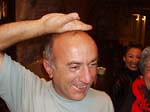light one candle
I am also still holding in my mind's hand the kavannot (intentions) that I brought with me on retreat. (For a thoughtful and characteristically heartful post by Ashley on kavannot, see this from last summer.)
Rabbi Ted encourages us to light each candle of Chanukkah for the illumination of a particular quality or intention, keeping in mind that the first candle is lit anew every night during the week-long holiday, and so on, and so we make our fondest wishes the first ones. The places and qualities I wished for the lights to illuminate: that field beyond rightdoing and wrongdoing. Faith in each soul's essential good. Willingness to listen for the call to prayer/action. The capacity for quick and whole-hearted connection. Willingness to take responsibility for what has heart and meaning. A deeper remembering to bless and be blessed. To pay full attention, to slow down enough to notice the details.
One of my favorite image details is seeing several Israelis, including our friend and bus driver Ovad, turn their hand over, palm up, to cover their head during a blessing. Rabbi Ted explained that in some Jewish traditional cultures, if a man didn't have a head covering to use during a prayer, he covered his head with one hand, in which case it was important to do so in a way that wasn't just your ordinary, everyday, kind of hand-on-your-head.
 |
| Here is Ovad during Chanukkah in Tzfat, with me, and part of Helen, in the background. |
